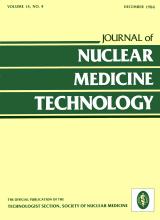Abstract
Lung-to-heart quantification, when used in conjunction with visual assessment of 201Tl stress test images, has been found useful in diagnosing cardiac dysfunction. We evaluated three methods of quantification in terms of inter- and intraobserver variability and reproducibility. Fifty anterior 201Tl stress images were quantified by each of the following methods: Method A (sum region), which involved one region of interest (ROI) in the measurement of pulmonary activity relative to that of the myocardium; Method B (count density), which required two ROIs, the lung-to-heart ratio being dependent on count density; and Method C (maximum pixel), which used the gray scale of the computer to determine the most intense pixels in the lung field and myocardium. Statistical evaluation has shown that the three methods assess clinical data equally well. Method C was found to be most reproducible in terms of inter- and intraobserver variability (p = 0.0016 and 0.0083), followed by Methods A (p = 0.0026 and 0.0129) and B (p = 0.0038 and 0.0135). Although nearly equivalent in terms of statistics, the three methods possess inherent differences and therefore should not be used interchangeably without conversion factors.







